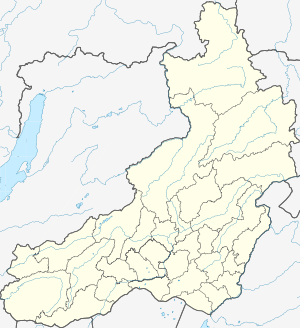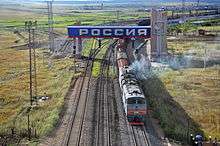Zabaykalsk

| Zabaykalsk (English) Забайка́льск (Russian) | |
|---|---|
| - Urban-type settlement - | |
|
| |
.svg.png) Location of Zabaykalsky Krai in Russia | |
 Zabaykalsk | |
|
| |
.png) | |
|
| |
| Administrative status | |
| Country | Russia |
| Federal subject | Zabaykalsky Krai |
| Administrative district | Zabaykalsky District |
| Administrative center of | Zabaykalsky District |
| Municipal status | |
| Municipal district | Zabaykalsky Municipal District |
| Urban settlement | Zabaykalskoye Urban Settlement |
| Administrative center of | Zabaykalskoye Urban Settlement |
| Statistics | |
| Population (2010 Census) | 11,769 inhabitants[1] |
| Time zone | YAKT (UTC+09:00)[2] |
| Otpor station | 1904 |
| Urban-type settlement status since | 1954 |
| Postal code(s)[3] | 674650 |
| Dialing code(s) | +7 674650 |
| Zabaykalsk on Wikimedia Commons | |
Zabaykalsk (Russian: Забайка́льск) is an urban locality (an urban-type settlement) and the administrative center of Zabaykalsky District of Zabaykalsky Krai, Russia, located on the Sino-Russian border just opposite the Chinese border town of Manzhouli. Population: 11,769 (2010 Census);[1] 10,210 (2002 Census);[4] 8,632 (1989 Census).[5]
Geography
The formerly disputed Abagaitu Islet in the Argun River is located about 100 kilometers (62 mi) to the east.
History
It was founded in 1904 as a station (Razyezd 86, i.e. "Passing loop No. 86") on the Chinese Eastern Railway.
Since 1924, a border guard detachment has been stationed there. In the aftermath of the Sino-Soviet conflict (1929) the station was renamed Otpor ("Repulse").[6]

Until the mid-1930s, Razyezd 86 / Otpor had little significance as a station, as all border formalities were done at Matsiyevskaya station (deeper into Russia) and at Manzhouli, on the Chinese side of the border. The station was expanded in the mid-1930s, as the railway on the Chinese side had been sold by the USSR to Manchukuo and converted from the 1,520 mm (4 ft 11 27⁄32 in) gauge of the Russian Railways to the 1,435 mm (4 ft 8 1⁄2 in) China Railways; Otpor thus became the last Russian-gauge station. The station became quite important in 1945, as one of the bases of the Soviet invasion of Manchuria (1945), which also saw the rail line on the Chinese side temporary re-converted to Russian gauge. The station's importance continued as the main rail connection between the USSR and the Communist China. On China's request, in 1958 the Soviets changed the name "Otpor" to the neutral Zabaykalsk (i.e., "a city in Transbaikalia", or "a city beyond Lake Baikal").[6]
Otpor Incident
The incident which later became known as the Otpor Incident occurred in 1938, when the many Jews who fled the Nazi Germany were stranded in Otpor (Zabaykalsk), asking entry into Manchukuo. Major General Kiichiro Higuchi of the Harbin branch of Kwantung Army, assisted by Norihiro Yasue and supported by Yosuke Matsuoka in Japan, let the Jewish refugees enter Manchukuo and further move to Shanghai or Japan, in spite of Japan's alliance with Germany at that time.[7]
Transportation
The Russo-Chinese highway AH6 passes through the town.
Zabaykalsk/Manzhouli is one of the three direct connections between Russian and Chinese Railways. The other two are in Primorsky Krai, much farther to the east; besides, much traffic between Russia and China travels on the rail line crossing Mongolia. It is served by what is now officially called the Southern Branch of the Transbaykal Railway (Южный ход Забайкальской железной дороги): a line that branches off the present-day main Trans-Siberian Railway line at Karymskaya junction (east of Chita), and continues southeast toward the Chinese border. Originally (until 1916), this line was part of the main Moscow-to-Vladivostok rail route, where trains coming from the west would continue into China on the former Chinese Eastern Railway, in order to cut across Manchuria on their way to Russian Vladivostok. After the modern route of the Trans-Siberian Railway, located entirely within Russian national territory, was completed in 1916, the Southern Branch's role was restricted to that of servicing Russia's border communities, and providing connectivity to China.
Zabaykalsk has been a transshipment station for a break of gauge since the 1930s, when the railway on the Chinese side had been sold by the USSR to Manchukuo and converted from the 1,520 mm (4 ft 11 27⁄32 in) gauge of the Russian Railways to the 1,435 mm (4 ft 8 1⁄2 in) China Railways.
Since 2005, a number of projects have been carried out to increase the capacity of the "Southern Branch", and its connection to China. The goal was to enable the railway by 2010 to handle 30 trains in each direction, each one up to 71 cars long. By 2005, the maximum weight of the trains using the line had already been increased from 4,000 to 6,300 tons.[8]
In 2008, TransContainer's container transshipment facility was expanded.[9] Work on modernizing the facility for passenger railcar bogie exchange was conducted as well.[10]
Notable residents
- Lidia Bobrova, film director
See also
References
- 1 2 Russian Federal State Statistics Service (2011). "Всероссийская перепись населения 2010 года. Том 1" [2010 All-Russian Population Census, vol. 1]. Всероссийская перепись населения 2010 года (2010 All-Russia Population Census) (in Russian). Federal State Statistics Service. Retrieved June 29, 2012.
- ↑ Правительство Российской Федерации. Федеральный закон №107-ФЗ от 3 июня 2011 г. «Об исчислении времени», в ред. Федерального закона №271-ФЗ от 03 июля 2016 г. «О внесении изменений в Федеральный закон "Об исчислении времени"». Вступил в силу по истечении шестидесяти дней после дня официального опубликования (6 августа 2011 г.). Опубликован: "Российская газета", №120, 6 июня 2011 г. (Government of the Russian Federation. Federal Law #107-FZ of June 31, 2011 On Calculating Time, as amended by the Federal Law #271-FZ of July 03, 2016 On Amending Federal Law "On Calculating Time". Effective as of after sixty days following the day of the official publication.).
- ↑ Почта России. Информационно-вычислительный центр ОАСУ РПО. (Russian Post). Поиск объектов почтовой связи (Postal Objects Search) (Russian)
- ↑ Russian Federal State Statistics Service (May 21, 2004). "Численность населения России, субъектов Российской Федерации в составе федеральных округов, районов, городских поселений, сельских населённых пунктов – районных центров и сельских населённых пунктов с населением 3 тысячи и более человек" [Population of Russia, Its Federal Districts, Federal Subjects, Districts, Urban Localities, Rural Localities—Administrative Centers, and Rural Localities with Population of Over 3,000] (XLS). Всероссийская перепись населения 2002 года [All-Russia Population Census of 2002] (in Russian). Retrieved August 9, 2014.
- ↑ Demoscope Weekly (1989). "Всесоюзная перепись населения 1989 г. Численность наличного населения союзных и автономных республик, автономных областей и округов, краёв, областей, районов, городских поселений и сёл-райцентров" [All Union Population Census of 1989: Present Population of Union and Autonomous Republics, Autonomous Oblasts and Okrugs, Krais, Oblasts, Districts, Urban Settlements, and Villages Serving as District Administrative Centers]. Всесоюзная перепись населения 1989 года [All-Union Population Census of 1989] (in Russian). Институт демографии Национального исследовательского университета: Высшая школа экономики [Institute of Demography at the National Research University: Higher School of Economics]. Retrieved August 9, 2014.
- 1 2 Пограничный разъезд номер 86 (затем Отпор, а ныне Забайкальск) (Border Passing loop No. 86 (later Otpor, and now Zabaykalsk)) (Russian)
- ↑ Report Reveals Japanese General Personally Saved 20,000 Jewish Refugees in 1938
- ↑ Забайкальская железная дорога | Инвестиционный проект "Южный ход" | Общие сведения (Transbaikal Railway: The Southern Branch investment project: General information) (Russian)
- ↑ Railway Gazette International November 2008, p845
- ↑ "Реконструкция пункта перестановки вагонов: В круглосуточном режиме на станции Забайкальск Забайкальской железной дороги ведется реконструкция пункта перестановки пассажирских вагонов". Transbaikalian Railway official web site. 2008-06-08. Archived from the original on 2012-03-01. ("Reconstruction of the bogie exchange facility: workers at Zabaykalsk Station of the Transbaikalian Railway are working round the clock, renovating the passenger railcar bogie exchange facility") (Russian)
External links
| Wikivoyage has a travel guide for Zabaikalsk. |